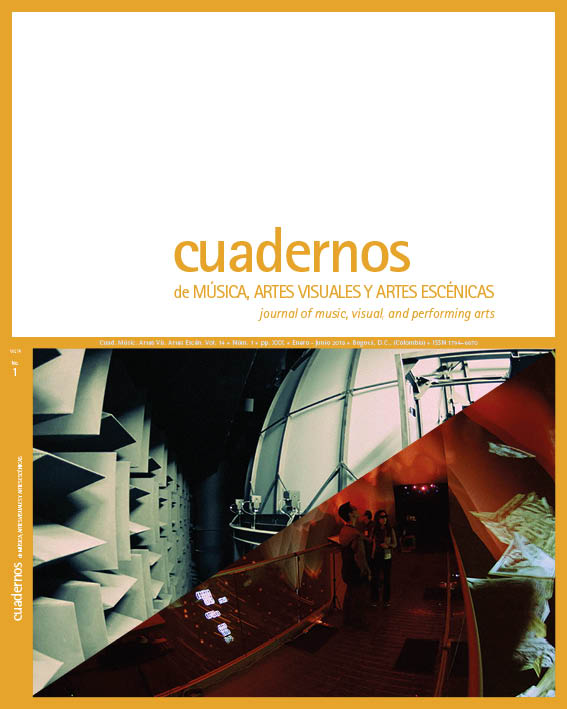Resumen
El artículo analiza los imaginarios y espacios sonoros en tres películas chilenas recientes producidas por la productora Diluvio: Lucía (Atallah 2010), Rey (Atallah 2017) y La casa lobo (Cociña y León 2018). A partir de estos filmes, estudiaremos los diversos usos del sonido como un dispositivo estratégico para resignificar tanto las propuestas narrativas como los materiales audiovisuales utilizados. Las películas estudiadas comparten ciertos aspectos de un cine de ficción de tipologías realistas, al modo en que lo comprenden algunos teóricos del realismo, junto con la representación subjetiva y expresiva del cine experimental y expandido. Proponemos una lectura de obra desde el lugar bisagra entre lo cinematográfico y las artes visuales, deteniéndonos en las diferentes prácticas de cada obra, para exponer y contrastar los diferentes usos del sonido que van tensando los modos de trabajar los ruidos, el silencio, el fuera de campo, el sonido de los materiales de expresión y la construcción y destrucción de lo sonoro y lo plástico.
Atallah, Niles (Director). 2007. Lucía. Chile: Niles Atallah, Francisco Albornoz.
— 2017. Rey. Chile: Coproducción Chile-Francia-Países Bajos (Holanda)-Alemania-Qatar.
Bachelard, Gastón. 2000. Poética del espacio. Buenos Aires: Fondo de Cultura Económica.
Baus, Martín. 2018. “La ley del desajuste: decalaje, emancipación y reverberancias del sonido en el cine
chileno”. Campo contra Campo. http://campocontracampo.cl/textos/12.
Bellour, Raymond. 1999. “La doble hélice”. http://campostrilnick.org/wp-content/uploads/2012/02/La-dobleh%
C3%A9lice1.pdf.
— 2009. Entre imágenes: foto, cine, video. Buenos Aires: Coluhue.
Burch, Noel. 2006. Praxis del cine. Madrid: Fundamentos.
Bresson. Robert. 1979. Notas del cinematógrafo. México: ERA.
Chion, Michael. 1993. La audiovisión: introducción a un análisis conjunto de la imagen y el sonido.
Bercelona: Paidós.
— 1995. La música en el cine. Barcelona: Paidós.
Cociña, Joaquín y Cristóbal León (Directores). 2018. La casa lobo. Chile: Diluvio.
Deleuze, Gilles. 1987. La imagen-tiempo. Barcelona: Paidós.
— 2002. Francis Bacon: la lógica de la sensación. Madrid: Arena.
Di Bella, Daniela V. 2018. “Ex obra, la rematerialización de la imagen en movimiento”. Cuadernos del Centro de
Estudios en Diseño y Comunicación. Ensayos 66: 1-10. http://www.scielo.org.ar/scielo.php?script=sci_
arttext&pid=S1853-35232018000100009
Jullier, Laurent. 2007. El sonido en el cine: imagen y sonido; un matrimonio de conveniencia. Barcelona: Paidós.
Lippit. Akira Mizuta. 2012. “Ex-Cinema: From a Theory of Experimental Film and Video”. Berkeley: University
of California Press.
Reyes, Juan. 2005. “Háptica y sonido: introducción a la síntesis escaneada”. https://www.maginvent.org/
articles/hapticscan/hapticscan.html.
Szendy, Peter. 2015. En lo profundo de un oído: una estética de la escucha. Santiago de Chile: Metales Pesados.
Tassara, Mabel y Kirchheimer, Mónica, comps. 2016. Animación: encuentros de lenguajes, géneros y figuras.
Buenos Aires: Imago Mundi.
Youngblood, Gene. 2012. Cine expandido. Buenos Aires: Universidad Nacional de Tres de Febrero.
Esta revista científica se encuentra registrada bajo la licencia Creative Commons Reconocimiento 4.0 Internacional. Por lo tanto, esta obra se puede reproducir, distribuir y comunicar públicamente en formato digital, siempre que se reconozca el nombre de los autores y a la Pontificia Universidad Javeriana. Se permite citar, adaptar, transformar, autoarchivar, republicar y crear a partir del material, para cualquier finalidad, siempre que se reconozca adecuadamente la autoría, se proporcione un enlace a la obra original y se indique si se han realizado cambios. La Pontificia Universidad Javeriana no retiene los derechos sobre las obras publicadas y los contenidos son responsabilidad exclusiva de los autores, quienes conservan sus derechos morales, intelectuales, de privacidad y publicidad.
El aval sobre la intervención de la obra (revisión, corrección de estilo, traducción, diagramación) y su posterior divulgación se otorga mediante una licencia de uso y no a través de una cesión de derechos, lo que representa que la revista y la Pontificia Universidad Javeriana se eximen de cualquier responsabilidad que se pueda derivar de una mala práctica ética por parte de los autores. Como consecuencia de la protección brindada por la licencia de uso, la revista puede publicar retractaciones o corregir la información ya publicada. La publicación de contenidos en esta revista no representa regalías para los contribuyentes.



